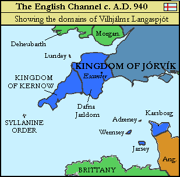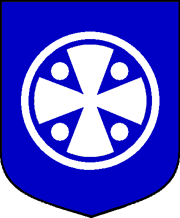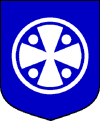| Establishment | c. 930 (de facto) 1018 (papal decree) |
| Disestablishment | c. 1400 |
| Languages | Kernowek, Ecclesiastical Latin |
| Capital | St. Elid, St. Mary |
| Government type | Monastic |
| Area | 16 km² |
| Population | 1,000 maximum |
The Syllanines were a Cornish monastic order that ruled the Isles of Syllan, or Scilly, for some centuries.
Background[]
The kingdom of Kernow is called Cornwall in OTL English and Kornland in Englesk. It was harassed by its neighbors throughout the Anglo-Saxon era; the Viking defeat of Cornwall's Saxon enemies in the Ninth Century helped the little kingdom preserve its independence. Kernow was a tempting prize for the Danish chieftain Hrolfr the Northman, Jarl of Dafna, or Devon. He invaded and placed his son on the throne in 904, taking great care to keep his new kingdom separate from the Viking kingdom of Jórvík on the other side of the border.
Hrolfr's son Vilhjalmir (William) Longsword extended Kernow's domains by conquering the Channel Islands and raiding the French and Breton coasts. But he and his successors were far more interested in ruling Cornwall than in governing their English fief. Gradually, they ceased to be Anglo-Nordic overlords of Kernow and became more like rulers of an independant Cornish kingdom.
For over a century the kings of Jórvík, Dublin, and other neighboring states repeatedly asserted their overlordship in Kernow. Many Viking chieftains landed in the kingdom and received the kings' submission, but the country's isolation allowed it to avoid control by any outside power. Cnut of Denmark's conquest of England in the Eleventh Century also left Kernow alone. Afterward, when England became an independent and unified kingdom with lands on both sides of the Irish Sea, Cornwall was finally joined to the larger country. By then, most of its aristocratic families had died out.
The Isles of Syllan were officially part of Kernow, but the kings only occasionally had actual control over them. During the age of the Viking raids the Isles were attacked repeatedly. The situation grew worse after c. 920, when some Vikings began to use the isles as a setting-off point for raids on the European continent. None of them showed enough interest in the Isles to conquer or settle them, but the raids were enough to permanently separate Syllan from the rest of Kernow. After the death of William Longsword in 960, no Cornish king made a serious effort to rule the islands, being far more concerned with their larger possessions in the Channel.
The Order[]

Situation in the Channel at the time of the Order's founding
The monasteries had been the basis for societal organization in the Syllan Isles long before Kernow even had its own king. The chaos caused by the Norse left the monasteries as Syllan's most permanent social institution. In c. 930 the Abbot of St. Elid, the Isles' oldest, formed the monasteries into a tightly organized Order, with control of the Isles' land, food production, and defense.
The Isles' isolation attracted many monks and nuns from across the British Isles. A number of archaic Celtic Christian practices could be found in Syllan after they had died out in Scotland and Ireland. However, the Order was not completely cut off from wider Christendom. It was influenced by the Clunaic movement after c. 1000, and in 1018 some of the Order's leaders made a pilgrimage to Rome. They managed an audience with Pope Sixtus IV, who recognized the Syllanines as an independent order, Ordo Scilloniensis. Around the same time, the center of power shifted from the tiny isle of St. Elid to the newer monastery of St. Mary, on the largest island.
Syllanine artistic works are admired today for their austere beauty. Anything ornate or expensive would be stolen by Vikings, so the monks emphasized simplicity. Syllanine calligraphy was developed into a remarkable art form, but featured no illumination or illustrations and used few colors. Excellent crosses and sculptures were carved into outcroppings of rock that could not be smashed or carried away. The Clunaics on the Continent contributed an emphasis on the liturgy as an art form, very appealing to the Syllanines. The Clunaics' love of ornateness and avoidance of manual labor, on the other hand, did not fit the realities of life on the Isles.
Later history[]
It was only at the end of the medieval era that England finally began to exercise real authority over the Isles. By that time the Cornish language was already dying out in much of Cornwall. Syllan remains one of the last Cornish-speaking places. The Order itself was absorbed into a larger monastic movement around this time, and the several monasteries were merged into one, St. Mary.
Seal and arms[]

The Order's shield of arms
The order used a seal from its early days that took the form of one variety of ringed Celtic cross used in Kernow, with small circles representing the isles. During the Crusading era the seal was formalized as a coat of arms, making it one of Europe's oldest heraldic symbols. It was colored blue for the sea, and the writing that had appeared around the outer ring was removed. The arms are blazoned: "Azure, within an annulet argent a cross patée-alisee argent between four plates."
The symbol is known locally as St. Mary's Cross and is still used today as a symbol of the Isles of Syllan.
Ethelred the Pious |
|---|
|
|

